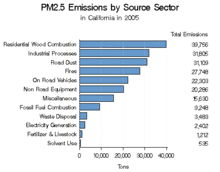Pollution in California

Pollution in California relates to the degree of pollution of air, water and land in the state of California. Studies show that some pollutants may be linked to increases in the rate of occurrence of cancers and birth complications.[1] In 2008, Bakersfield, California recorded the highest level of airborne pollutants of any state in the United States.[2]
Water pollution is defined by the Federal Clean Water Act as "dredge spoil, solid waste, incinerator residue, sewage, garbage, sewage sludge, munitions, chemical wastes, biological materials, heat, wrecked or discarded equipment, rock, sand, cellar dirt, and industrial, municipal, and agricultural waste discharged into water." [3] More generally, pollution is defined as the introduction of contaminants into the natural environment that cause adverse change.[4]
Causes
Air pollution comes from a number of sources, and the amount of pollutant from each source is different from place to place. Particulate pollution sources are shown in the graph at right. Residential wood combustion, such as burning wood in fireplaces, is the largest source of PM 2.5 pollution.

The Clean Air Act requires the US EPA to regulate six common pollutants. These air pollutants (also known as "criteria pollutants") are found all over the United States. They are particle pollution, ground-level ozone, carbon monoxide, sulfur oxides, nitrogen oxides, and lead. All of these pollutants have been shown to have adverse health and environmental impacts and some can cause property damage. Of the six pollutants, particle pollution and ground-level ozone are the most widespread health threats. EPA calls these pollutants "criteria" air pollutants because it regulates them by developing human health-based and/or environmentally based criteria (science-based guidelines) for setting permissible levels.
Land pollution is principally caused by thoughtless or illegal disposal of waste waters or solids containing pollutants. Dumping garbage, and littering on the ground, although unsightly, rarely cause much lasting damage unless the material contains non degradable materials such as many plastics or is at risk of entering a watercourse and thus eventually reaching the sea.
Effects
There are many possible outcomes from breathing polluted air. For example, affected populations can develop a higher risk for lung cancer by breathing polluted air. Studies have sometimes found that some pollutants have damaging effects on humans, especially during pregnancy. Studies done on humans exposed to pollutants, one of them being polychlorinated biphenyls, which causes decreased birth size, increased sexual development, and altered levels of hormones related to gland regulation.[5]
There are many possible outcomes from breathing polluted air. For example, affected populations can develop a higher risk for lung cancer by breathing polluted air. Studies have sometimes found that some pollutants have damaging effects on humans, especially during pregnancy. Studies done on humans exposed to pollutants, one of them being polychlorinated biphenyls, which causes decreased birth size, increased sexual development, and altered levels of hormones related to gland regulation.[6]
There are many possible outcomes from breathing polluted air. For example, affected populations can develop a higher risk for lung cancer by breathing polluted air.
Studies have sometimes found that some pollutants have damaging effects on humans, especially during pregnancy. Studies done on humans exposed to pollutants, one of them being polychlorinated biphenyls, which causes decreased birth size, increased sexual development, and altered levels of hormones related to gland regulation.[7]
There are many possible outcomes from breathing polluted air. For example, affected populations can develop a higher risk for lung cancer by breathing polluted air.
Studies have sometimes found that some pollutants have damaging effects on humans, especially during pregnancy. Studies done on humans exposed to pollutants, one of them being polychlorinated biphenyls, which causes decreased birth size, increased sexual development, and altered levels of hormones related to gland regulation.[8]
There are many possible outcomes from breathing polluted air. For example, affected populations can develop a higher risk for lung cancer by breathing polluted air.
Studies have sometimes found that some pollutants have damaging effects on humans, especially during pregnancy. Studies done on humans exposed to pollutants, one of them being polychlorinated biphenyls, which causes decreased birth size, increased sexual development, and altered levels of hormones related to gland regulation.[9]
See also
- California Air Resources Board
- California Environmental Protection Agency
- Climate change in California
- Environmental impact of shipping
- Global Warming Solutions Act of 2006
- Pollution in Long Beach, California
- List of Superfund sites in California
References
- ↑ Boxall, Bettina, et al. "L.A. air pollution may endanger babies, people in general." Los Angeles Times 25 June 2009: n. pag. Rpt. in Los Angeles times.
- ↑ Roosevelt, Margot. "Southern California's air pollution remains high." Los Angeles Times 28 Apr. 2009
- ↑ Water, article by Arnold S. Vernick, in Mark’s Standard Handbook for Mechanical Engineers, 11th Edition, McGraw Hill, New York, 2007.
- ↑ "Pollution - Definition from the Merriam-Webster Online Dictionary". Merriam-webster.com. 2010-08-13. Retrieved 2010-08-26.
- ↑ Schell, L. "Effects of pollution on human growth and development: an introduction". University at Albany.
- ↑ Schell, L. "Effects of pollution on human growth and development: an introduction". University at Albany.
- ↑ Schell, L. "Effects of pollution on human growth and development: an introduction". University at Albany.
- ↑ Schell, L. "Effects of pollution on human growth and development: an introduction". University at Albany.
- ↑ Schell, L. "Effects of pollution on human growth and development: an introduction". University at Albany.
External links
- BurningIssues/Clean Air Revival An educational California site on air pollution
- Breathe California